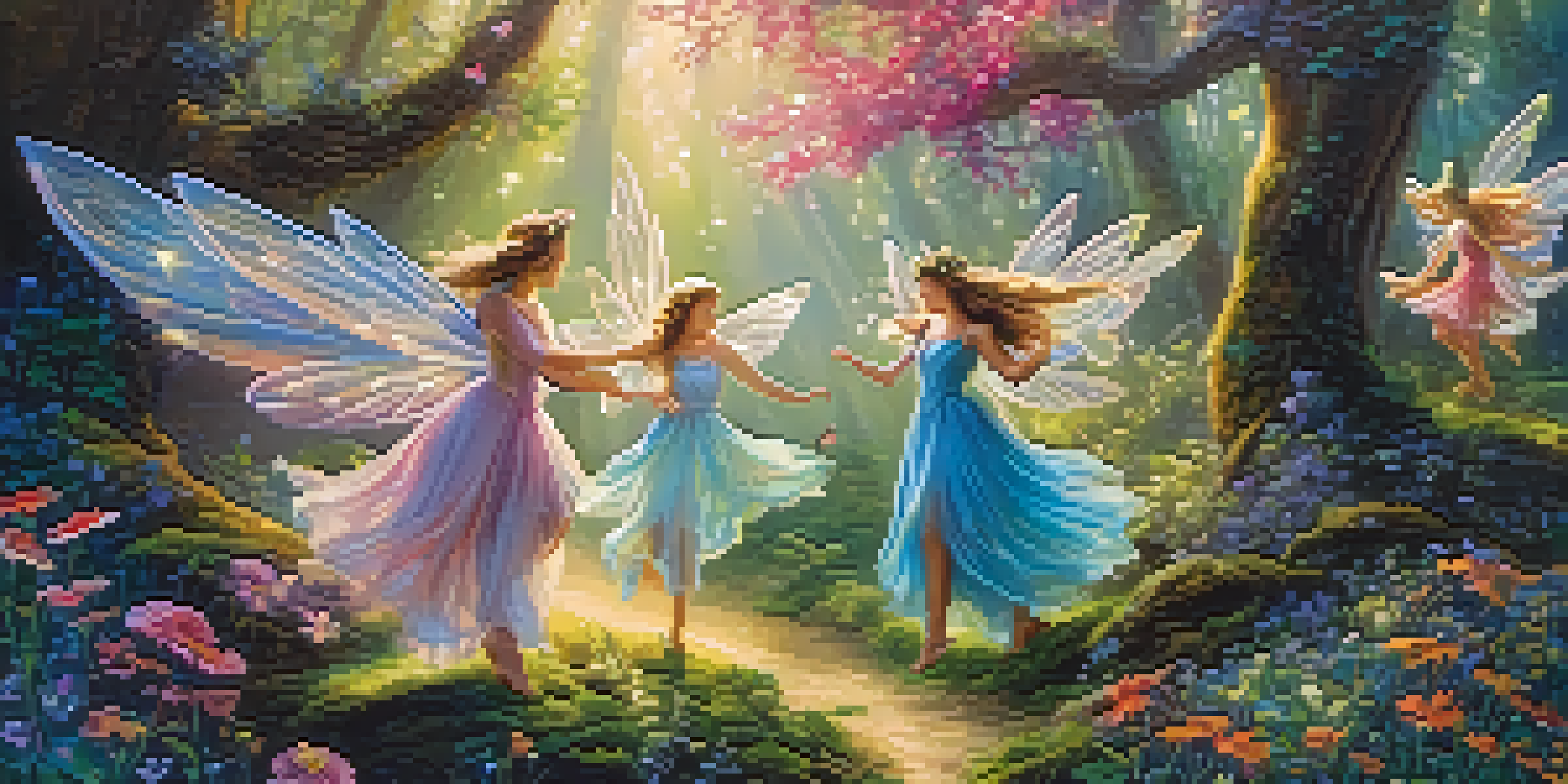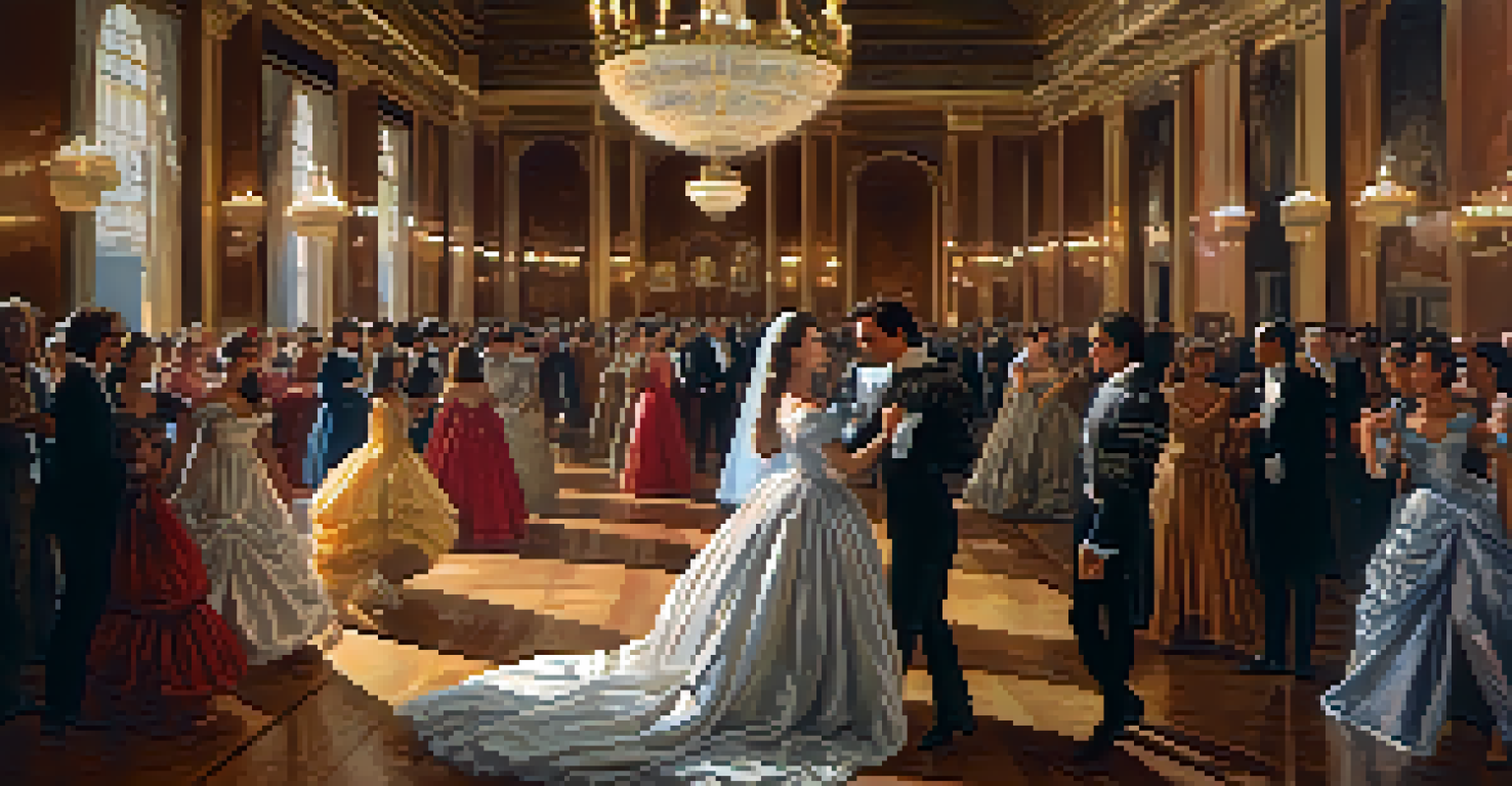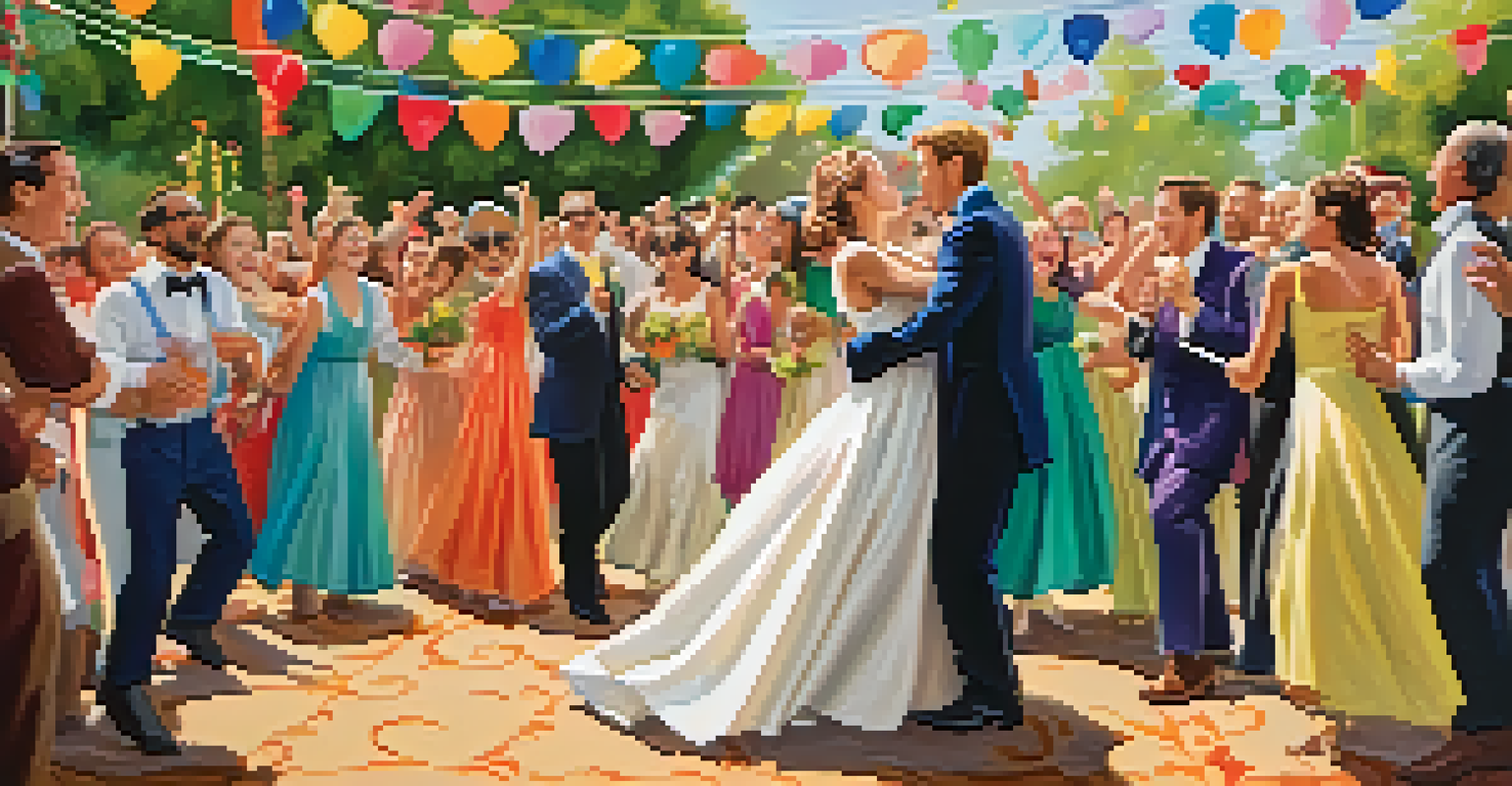The Role of Dance in Shakespeare’s Plays and Their Symbolism

Dance as a Reflection of Character and Emotion
In Shakespeare's plays, dance often serves as a mirror to the characters' emotions. For instance, in 'A Midsummer Night's Dream,' the playful and chaotic dance of the fairies reflects the whimsical nature of the enchanted forest. This connection between movement and emotion provides audiences with a deeper understanding of the characters’ inner turmoil or joy, enhancing the narrative.
All the world's a stage, and all the men and women merely players.
Moreover, dance can also signify transformation. In 'Romeo and Juliet,' the masquerade ball scene is pivotal; it symbolizes new beginnings and the potential for love amidst societal constraints. The act of dancing allows characters to shed their identities temporarily and embrace new possibilities, illustrating the power of movement in shaping relationships.
Thus, Shakespeare uses dance not only as a form of entertainment but as a profound tool for character development and emotional expression. By engaging in dance, characters reveal their desires and conflicts, making it an essential element of storytelling.
The Role of Dance in Social Commentary
Dance in Shakespeare's plays often serves as a vehicle for social commentary, highlighting the norms and expectations of society. For example, in 'Twelfth Night,' the festive dances underscore themes of disguise and identity, revealing societal constraints on gender roles. Through dance, Shakespeare critiques the rigid structures that dictate personal freedom and expression.

Additionally, the inclusion of dance can elevate the stakes of social interactions. In 'Much Ado About Nothing,' the lively dances at the wedding celebration contrast sharply with the underlying tensions of deception and betrayal, illustrating how appearances can be deceiving. This juxtaposition invites the audience to reflect on the complexities of social dynamics.
Dance Mirrors Emotion and Character
In Shakespeare's plays, dance reflects characters' emotions and transformations, enhancing the narrative by revealing their inner struggles and desires.
Thus, dance becomes a powerful metaphor for societal norms, allowing Shakespeare to explore and challenge the status quo. Through the rhythm and movement of dance, he invites audiences to engage with issues of identity, love, and deception.
Dance as a Means of Celebration and Community
In many of Shakespeare's works, dance represents community and celebration, bringing characters together in joyous moments. For instance, in 'As You Like It,' the pastoral dances in the Forest of Arden symbolize unity and camaraderie among the characters, reinforcing the play’s themes of love and friendship. These scenes create a sense of belonging, highlighting the importance of community in the human experience.
The dance of death is a dance of life.
Moreover, dance often marks significant events or turning points in the narrative. In 'The Tempest,' the enchanting dance of spirits celebrates the resolution of conflicts and the restoration of harmony. This celebratory aspect of dance not only enhances the festive atmosphere but also signifies hope and renewal.
Through these communal dances, Shakespeare emphasizes the joy of togetherness and the collective human spirit. Whether in moments of triumph or reconciliation, dance serves as a reminder of the bonds that unite us, reinforcing the play’s overarching themes.
Symbolism of Dance in Romantic Relationships
Romantic relationships in Shakespeare's plays are often illuminated through the lens of dance, symbolizing attraction and connection. In 'Much Ado About Nothing,' the witty exchanges during the dance scenes highlight the playful courtship between Beatrice and Benedick, illustrating how dance can serve as a metaphor for the intricacies of romance. Their banter, set against the backdrop of dancing, conveys the excitement and tension inherent in their relationship.
Similarly, the dance in 'Romeo and Juliet' acts as a catalyst for their fateful love story. The moment they first meet at the Capulet ball is underscored by the rhythm of dance, emphasizing the instantaneous attraction and connection between the two. This intertwining of dance and romance creates a vivid portrayal of love’s spontaneity and intensity.
Dance as Social Commentary
Shakespeare uses dance to critique societal norms, illustrating themes of identity and deception while inviting audiences to reflect on social dynamics.
Through these examples, Shakespeare masterfully uses dance to symbolize the complexities of love, showcasing how movement can embody emotions that words alone cannot convey. The physicality of dance enhances the romantic narrative, making it an integral part of the storytelling.
Dance and the Supernatural in Shakespeare's Works
The supernatural elements in Shakespeare's plays are often accompanied by dance, emphasizing the otherworldly nature of these characters. In 'A Midsummer Night's Dream,' the ethereal dances of the fairies create a whimsical atmosphere, signaling their magical influence on the human realm. This portrayal of dance highlights the contrast between the ordinary and the extraordinary, drawing the audience into a realm of enchantment.
Additionally, in 'Macbeth,' the witches' eerie movements and chants during their scenes evoke a sense of foreboding and mystery. Their dance-like rituals symbolize the chaotic forces at play and foreshadow the tragic events that follow. Through this use of dance, Shakespeare conveys the power and unpredictability of the supernatural.
Thus, dance becomes a conduit for the supernatural, allowing Shakespeare to explore themes of fate, power, and the unknown. The rhythm and movement associated with these supernatural beings heighten the sense of wonder and danger in their presence.
The Significance of Dance in Shakespearean Comedies
In Shakespearean comedies, dance often plays a crucial role in resolving conflicts and bringing about happy endings. The joyous dances at the conclusion of plays like 'A Midsummer Night's Dream' serve as a celebration of love and reconciliation, reinforcing the theme of harmony restored. These dance scenes act as a release of tension, allowing characters and audiences alike to revel in the joy of resolution.
Moreover, comedic dances can also provide a platform for mistaken identities and humorous situations. In 'Twelfth Night,' the lively dances highlight the playful confusion surrounding the characters' disguises, adding an extra layer of humor to the narrative. This interplay between dance and comedy showcases Shakespeare's ability to blend movement with wit.
Dance Enhances Tragedy and Comedy
In Shakespearean works, dance amplifies emotional depth in tragedies and serves as a joyful resolution in comedies, showcasing the complexity of human experience.
Through these comedic elements, dance becomes a vital aspect of storytelling in Shakespeare's comedies, emphasizing the importance of joy and unity. It invites audiences to partake in the merriment, reinforcing the idea that laughter and dance are universal expressions of happiness.
The Impact of Dance on Shakespearean Tragedies
In contrast to comedies, dance in Shakespearean tragedies often underscores themes of loss and despair. For example, in 'Romeo and Juliet,' the celebratory dance at the Capulet ball foreshadows the tragic events that will unfold, creating a poignant sense of irony. This interplay between dance and tragedy heightens the emotional stakes, reminding audiences of the fragility of joy in the face of impending doom.
Additionally, dance can represent the internal struggles of characters grappling with fate. In 'Macbeth,' the haunting vision of Lady Macbeth sleepwalking and attempting to wash the blood from her hands can be seen as a metaphorical dance of guilt. This movement encapsulates her descent into madness, illustrating how dance can convey the psychological turmoil of tragedy.

Thus, Shakespeare employs dance as a means to amplify the emotional depth of his tragedies, creating a powerful contrast between joy and sorrow. The movement becomes a visceral representation of the characters' struggles, leaving a lasting impact on the audience.